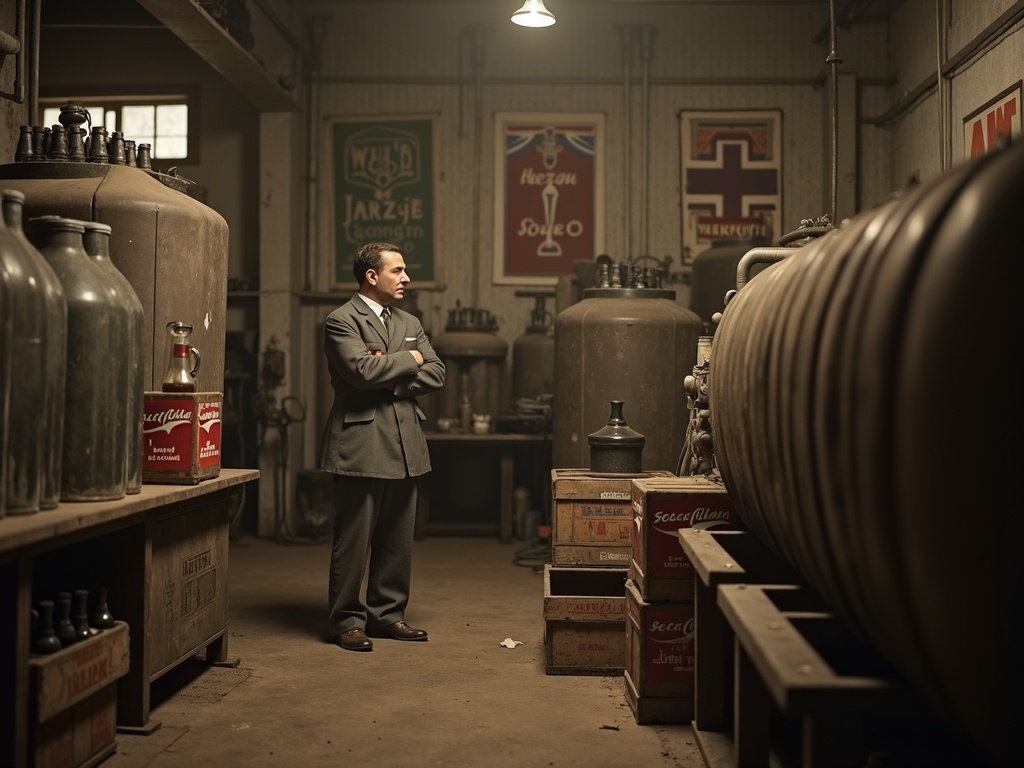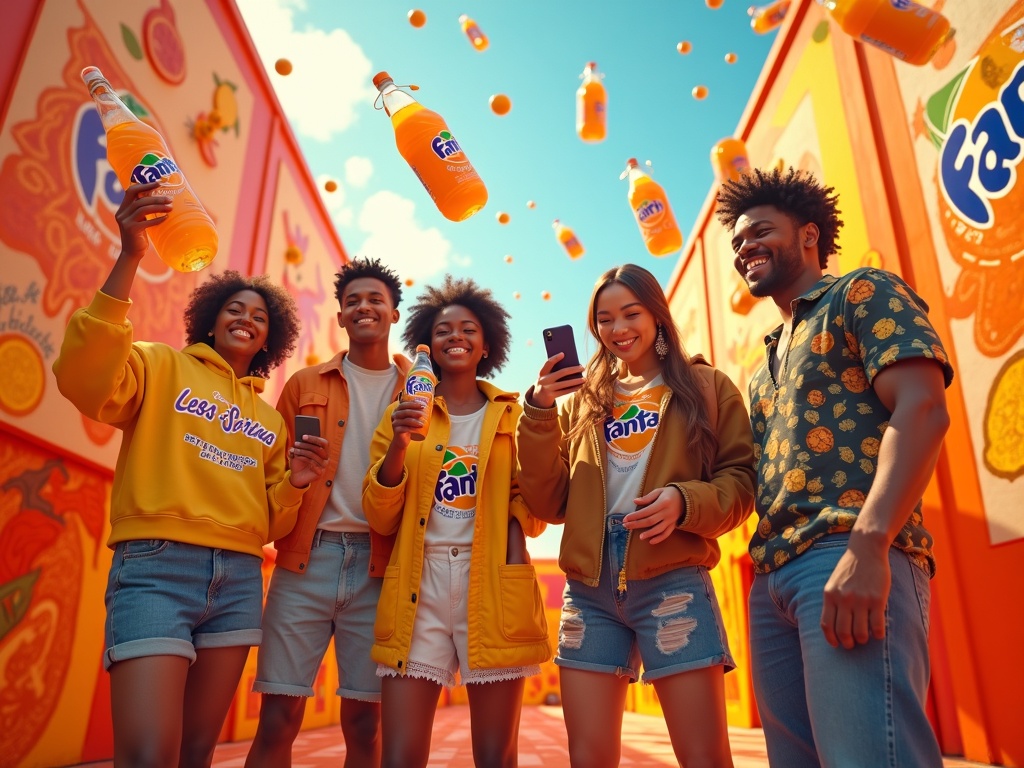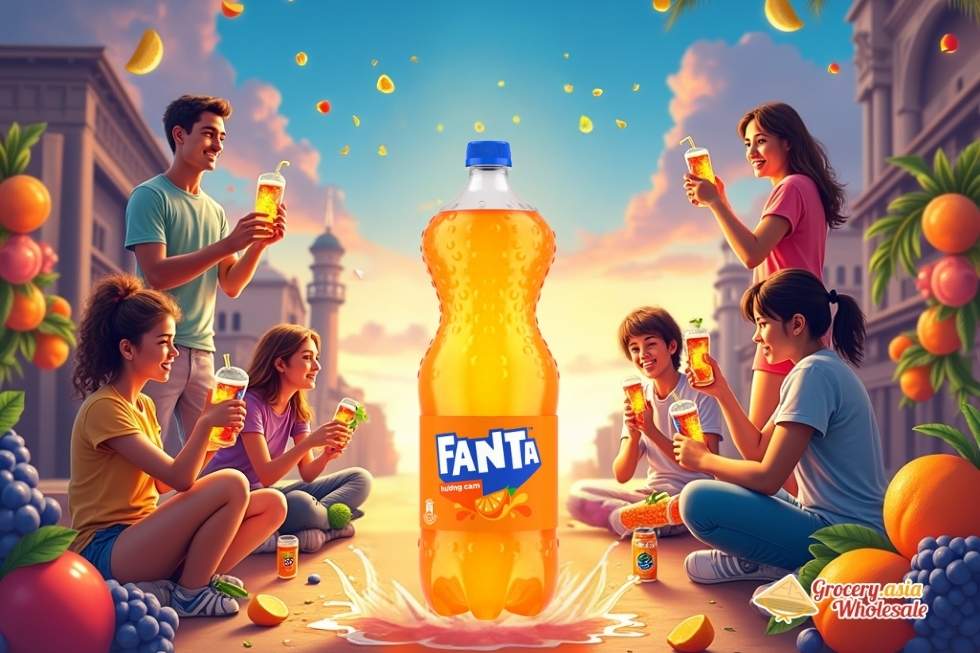No products in the cart.
Beverages News, Fanta Carbonated Soft Drinks, Soft Drinks
Who Owns Fanta Secrets Of A Soda Giant
Who owns Fanta is a question often asked by curious consumers and industry watchers alike. The Coca-Cola Company maintains complete ownership and control over Fanta, operating this global orange soda phenomenon from its Atlanta headquarters while generating over $1 billion in annual retail sales across more than 190 countries. Despite Fanta’s unusual World War II origins as a wartime substitute drink in Nazi Germany, The Coca-Cola Company has transformed it into one of the planet’s most recognizable soft drink brands, offering over 200 flavor variations tailored for local markets worldwide.
Table of Contents
Key Takeaways
- The Coca-Cola Company owns Fanta completely, controlling all strategic, financial, and operational decisions for the brand while leveraging its global distribution network and manufacturing capabilities to maintain Fanta’s position as a billion-dollar asset.
- Fanta originated in Nazi Germany during 1940 as a wartime substitute when trade embargoes cut off Coca-Cola syrup supplies. It was originally made from apple pomace, whey, and food scraps before being completely reformulated after the war.
- The brand operates in over 190 countries with more than 130 million servings consumed daily worldwide. Fanta ranks as the fourth largest carbonated soft drink brand globally by volume.
- Fanta offers more than 200 unique flavor variations across different markets, using hyper-localization strategies to match regional taste preferences rather than maintaining a standardized global formula.
- Marketing targets Gen Z consumers through vibrant colors, high-energy campaigns, and innovative packaging like the proprietary spiral-shaped bottle introduced in 2017. The brand positions itself as playful and “less serious” compared to traditional soft drink brands.
To learn more about Fanta and its parent company, visit The Coca-Cola Company’s official Fanta page.
Who Owns Fanta? The Coca-Cola Company’s Role
The Coca-Cola Company stands as the undisputed owner and operator of Fanta, controlling every aspect of this global orange soda phenomenon from its headquarters in Atlanta, Georgia. This multinational beverage giant doesn’t just own Fanta – it completely orchestrates the brand’s strategy, operations, and financial direction across more than 190 countries worldwide.
Fanta’s creation dates back to 1940, making it Coca-Cola’s second oldest brand after the flagship Coca-Cola beverage, which first appeared in 1886. However, the modern Fanta Orange that consumers recognize today emerged in 1955 when Coca-Cola relaunched the brand in Naples, Italy, using locally sourced citrus fruits to create a fresher, more authentic flavor profile.
A Billion-Dollar Asset in Coca-Cola’s Portfolio
Fanta’s financial performance justifies Coca-Cola’s continued investment in the brand. Fanta ranks among The Coca-Cola Company’s “billion-dollar brands”, generating over $1 billion in annual retail sales globally. This impressive revenue stream positions Fanta as a critical component within Coca-Cola’s extensive beverage portfolio.
The brand operates alongside other major Coca-Cola properties, each serving distinct market segments:
- Sprite appeals to lemon-lime soda enthusiasts
- Minute Maid dominates the juice and juice drink category
- Powerade competes in the sports drink market
- Dasani captures the bottled water segment
- Fanta soda holds the orange-flavored carbonated beverage space
While Fanta maintains its unique brand identity and marketing campaigns, The Coca-Cola Company makes all strategic, financial, and operational decisions for the brand. This centralized control allows Coca-Cola to leverage its global distribution network, manufacturing capabilities, and marketing expertise to maximize Fanta’s reach and profitability.
The company’s ownership extends beyond traditional orange Fanta to include various product innovations like Fanta Jelly Fizz and numerous regional flavor variations. Each product development initiative flows through Coca-Cola’s research and development teams, ensuring consistency with the parent company’s quality standards and brand vision.
Coca-Cola’s control over Fanta isn’t merely about ownership — it’s about integration into a sophisticated global beverage ecosystem. The company utilizes its massive supply chain infrastructure, established relationships with bottling partners, and decades of marketing expertise to maintain Fanta’s position as one of the world’s most recognizable soft drink brands.
This ownership structure provides Fanta with significant advantages. Coca-Cola’s financial resources enable substantial marketing investments, continuous product innovation, and rapid expansion into emerging markets. The parent company’s established distribution channels ensure Fanta reaches consumers in remote locations where independent brands might struggle to penetrate.
The strategic value of Fanta within Coca-Cola’s portfolio becomes clear when examining market dynamics. While cola-flavored beverages face increasing health consciousness concerns, fruit-flavored sodas like Fanta often maintain stronger appeal among consumers seeking variety. This positioning allows Coca-Cola to capture market share across multiple beverage categories while maintaining its dominant position in the global soft drink industry.

Fanta’s Surprising World War II Origins
I can trace Fanta’s origins back to one of history’s most challenging periods. The brand emerged in Nazi Germany during 1940, born from necessity rather than innovation. When wartime trade embargoes cut off the supply of Coca-Cola syrup to Germany, Max Keith, who headed Coca-Cola Deutschland, faced a critical decision: shut down operations or create something entirely new.
Keith chose to adapt. He developed Fanta as a substitute drink to keep the German bottling plant running during the war. The original formula bore no resemblance to the vibrant, fruit-flavored Fanta we know today. Instead, Keith’s team crafted their beverage from whatever food scraps and byproducts they could find.
Creating Something from Nothing
The ingredients varied dramatically based on availability, but the original Fanta typically contained:
- Apple pomace (leftover fibers from cider pressing)
- Whey (protein-rich liquid byproduct from cheese making)
- Various other food scraps and sweeteners
The name itself reflects the desperation and creativity of the time. “Fanta” comes from the German word “Fantasie,” meaning imagination. Keith encouraged his team to use their imagination when creating this wartime substitute, and the name stuck.
This original Fanta was a beige-colored, sugary drink that looked nothing like today’s brightly colored sodas. The U.S.-based Coca-Cola Company had lost all contact and control over its German operations during the war, leaving Keith to make these decisions independently.
After the war ended, The Coca-Cola Company regained control of its German operations and completely reformulated the brand. The modern Fanta soda shares only its name with Keith’s wartime creation. Today’s fruit-flavored varieties represent a complete departure from those desperate wartime origins, transforming what began as a necessity into one of the world’s most recognizable soft drink brands.
This historical context explains why Fanta’s ownership story starts with such an unusual chapter, setting the stage for its eventual integration into The Coca-Cola Company’s global portfolio.

Who Owns Fanta Today? Global Reach and Market Numbers
The scope of Fanta’s global reach demonstrates The Coca-Cola Company’s exceptional distribution capabilities. Fanta is sold in more than 190 countries worldwide, making it available in nearly every nation on Earth. This extensive presence reflects decades of strategic expansion and adaptation to local tastes and preferences.
Daily consumption figures reveal the brand’s massive impact on global beverage habits. More than 130 million servings of Fanta and other Coca-Cola sparkling beverages are consumed every single day worldwide. To put this enormous number in perspective, that’s roughly equivalent to the entire population of Japan drinking a Fanta daily.
Market Leadership Across Continents
Fanta’s performance varies significantly across different regions, showing how Fanta became famous through regional adaptation. While Coca-Cola dominates most global markets, Fanta often surpasses its parent brand in popularity across Europe and South America. Countries like Germany, Brazil, and South Africa consider Fanta a cultural staple rather than just another soft drink option.
Brazil consistently ranks as one of Fanta’s largest and most important markets globally. The brand’s success in Brazilian culture extends far beyond simple beverage consumption, becoming integrated into local traditions and celebrations. This regional dominance contrasts sharply with markets like the United States, where Fanta remains popular but doesn’t achieve the same cultural significance or market leadership position.
Global Rankings and Market Position
Fanta holds the position of the fourth largest carbonated soft drink brand globally by volume. This ranking places it among an elite group of beverages that have achieved true worldwide recognition and sustained consumer loyalty. The brand’s ability to maintain this position across diverse markets speaks to its adaptability and appeal.
Regional popularity patterns reveal interesting consumer preferences that The Coca-Cola Company has successfully leveraged. In European markets, Fanta often outperforms Coca-Cola itself, while South American consumers have embraced various Fanta juice drink variations. These regional successes demonstrate how global brands can achieve local relevance through careful market understanding and product adaptation.
The numbers tell a compelling story of global expansion and consumer acceptance. From its availability in 190 countries to its daily consumption figures, Fanta represents one of the most successful international beverage brands ever created.

More Than Just Orange: Fanta’s Flavor Empire
I’ve discovered that Fanta operates one of the most diverse flavor portfolios in the beverage industry, with over 200 unique variations available across different markets. This extensive range reflects The Coca-Cola Company’s strategic approach to product localization, where flavors are specifically developed to match local taste preferences rather than forcing a one-size-fits-all formula.
The genius behind this approach lies in understanding that taste preferences vary dramatically across cultures and regions. While Fanta’s origins may have been simple, today’s brand has evolved into a sophisticated flavor empire that adapts to local palates with remarkable precision.
Regional Flavor Exploration
Each continent showcases distinct flavor profiles that reflect local fruit availability and cultural preferences.
- Europe leads with innovative combinations like Shokata, which blends elderflower and lemon for a refreshing European sensibility. The region also features Fristi (Fruit Twist) and exotic pairings like Mango & Passionfruit that cater to increasingly adventurous European consumers.
- Asian markets embrace tropical and unique flavors that aren’t found elsewhere. Melon Frosty captures the region’s love for melon varieties, while Lychee appeals to those familiar with this distinctly Asian fruit. Socata brings grape flavoring with a regional twist, and Fanta Premier Peach offers a premium positioning that resonates with quality-conscious consumers.
- North America sticks closer to familiar fruit flavors, featuring Pineapple, Grape, Strawberry, and Green Apple varieties. The inclusion of Piña Colada adds a tropical vacation vibe that appeals to the continent’s diverse population and their varied taste experiences.
- Africa enjoys flavors like Black Currant and Passion & Mango, which incorporate fruits that are both locally relevant and internationally appealing.
Even the iconic Fanta Orange demonstrates this localization strategy in action. The formula I encounter in the United States features orange coloring and high-fructose corn syrup, creating a sweeter, more artificial taste profile. Meanwhile, the U.K. version contains a higher percentage of actual fruit juice and uses real sugar, resulting in a more natural flavor that aligns with European preferences for authentic ingredients.
This hyper-localization strategy stands in stark contrast to Coca-Cola Classic’s standardized formula approach. While Coke maintains consistency worldwide, Fanta embraces variation as a core brand strength. This flexibility allows the brand to embed itself more deeply into local cultures, becoming less of an imported product and more of a locally relevant beverage choice.
The success of this approach is evident in how different regions have developed emotional connections to their specific Fanta flavors. A consumer in Thailand drinking Lychee Fanta experiences something completely different from someone in Germany enjoying Shokata, yet both feel connected to the same global brand identity.
I find this strategy particularly effective because it acknowledges that taste is deeply cultural. Rather than trying to educate consumers about unfamiliar flavors, Fanta meets them where they are, offering familiar taste profiles while maintaining the brand’s playful, refreshing character.
The brand’s flexibility extends beyond just flavor selection to include packaging, marketing messages, and even texture variations like jelly fizz formulations that appeal to specific market preferences.
This extensive flavor empire positions Fanta as more than just a soft drink brand – it’s become a platform for flavor innovation that respects local preferences while maintaining global brand recognition. The strategy has proven so successful that many consumers don’t realize they’re drinking flavors that might be completely unavailable just a few hundred miles away.
Targeting the Youth: Fanta’s Marketing Playbook
Fanta’s marketing strategy zeroes in on teenagers and young adults, specifically Gen Z consumers who crave authentic, playful brand experiences. The brand consistently positions itself as the antithesis of serious soft drink marketing, embracing a vibrant, irreverent approach that resonates with younger demographics seeking genuine fun over manufactured emotion.
Visual Identity and Campaign Evolution
The brand’s marketing arsenal relies heavily on bright, vibrant colors that pop across digital platforms and physical retail spaces. Animation plays a central role in Fanta’s campaigns, creating dynamic content that captures short attention spans and encourages sharing. High-energy music accompanies most promotional materials, establishing an instant connection with youth culture and trending sounds.
Fanta’s slogans have evolved to match this energetic positioning. The long-running “Wanta Fanta?” campaign established the brand’s playful voice, while the more recent “Less Serious” platform directly communicates the brand’s commitment to fun over formality. This strategic messaging differentiates Fanta from its parent company’s more traditional emotional appeals, carving out a distinct space in the carbonated beverage market.
The 2017 global rebranding marked a significant shift in Fanta’s visual strategy. The new, bold logo design embraced modern typography while maintaining the brand’s recognizable orange identity. This refresh wasn’t just cosmetic—it represented a comprehensive approach to capturing Gen Z’s attention across multiple touchpoints.
Revolutionary Packaging Innovation
Fanta’s introduction of the proprietary spiral-shaped bottle in 2017 demonstrates a sophisticated understanding of modern consumer behavior. This asymmetric design became the first of its kind for a major carbonated soft drink, breaking conventional packaging norms that had dominated the industry for decades.
The spiral bottle serves multiple strategic purposes beyond visual appeal:
- Tactile design creates a memorable physical interaction that boosts brand recall.
- Social media-friendly aesthetics encourage “Instagrammable” moments and organic sharing.
This packaging innovation addresses two critical marketing challenges simultaneously:
- Shelf differentiation in crowded retail environments where consumers make split-second decisions.
- Creating natural social media content opportunities, turning consumers into brand ambassadors.
Fanta’s marketing strategy deliberately contrasts with Coca-Cola’s emphasis on nostalgia, happiness, and togetherness. While the parent brand focuses on emotional connections, Fanta targets youthful, irreverent fun that caters to younger consumers’ desire for authenticity and self-expression.
Social media marketing forms the backbone of Fanta’s current approach. The brand creates content specifically designed for platform-native consumption, understanding that Gen Z consumers expect brands to speak their digital language fluently. This includes:
- TikTok-friendly video content
- Instagram-optimized imagery featuring the spiral bottle’s unique silhouette
The brand’s commitment to humor and playfulness extends beyond advertising into product development and consumer interaction. Fanta’s product innovations often emphasize texture, flavor surprises, and visual appeal that align with its marketing message of choosing fun over convention.
This comprehensive marketing playbook has positioned Fanta as more than just another fruit-flavored soda. By consistently targeting younger demographics with authentic, visually striking campaigns and innovative packaging, the brand has created a distinct identity that thrives in today’s social media-driven marketplace. The success of this approach is evident in Fanta’s continued relevance among Gen Z consumers who increasingly value brands that understand and reflect their digital-first lifestyle.

Sources:
The Coca-Cola Company, “The Story of Fanta”
Snopes, “Was Fanta Invented by the Nazis?”
Mark Pendergrast, “For God, Country, and Coca-Cola: The Definitive History of the Great American Soft Drink and the Company That Makes It”
Business Insider, “Fanta has more than 100 flavors — here are some of the craziest ones”
Design Week, “Fanta rebrands with new visual identity and ‘first ever’ asymmetric bottle”


